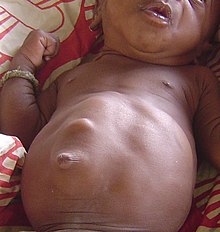Diastasis recti
| Diastasis recti | |
|---|---|
| Other names | Abdominal separation |
 | |
| Diastasis recti in an infant | |
| Specialty | Pediatrics |

Diastasis recti, or rectus abdominis diastasis, is defined as a gap of about 2.7 cm or greater between the two sides of the
Diastasis of the rectus abdominis muscle most frequently occurs in
Strength training of all the core muscles, including the abdominis recti muscle, may or may not reduce the size of the gap in pregnant or postpartum women.
Presentation
A diastasis recti may appear as a ridge running down the midline of the abdomen, anywhere from the xiphoid process to the umbilicus. It becomes more prominent with straining and may disappear when the abdominal muscles are relaxed. The medial borders of the right and left halves of the muscle may be palpated during contraction of the rectus abdominis.[5] The condition can be diagnosed by physical exam, and must be differentiated from an epigastric hernia or incisional hernia, if the patient has had abdominal surgery.[3] Hernias may be ruled out using ultrasound.[6]
In infants, they typically result from a minor defect of the linea alba between the rectus abdominis muscles. This allows tissue from inside the abdomen to herniate anteriorly. On infants, this may manifest as an apparent 'bubble' under the skin of the belly between the
Examination is performed with the subject lying on the back, knees bent at 90° with feet flat, head slightly lifted placing chin on chest. With muscles tense, the examiner then places fingers in the ridge that is presented. Measurement of the width of separation is determined by the number of fingertips that can fit within the space between the left and right
Diagnosis
- Diastasis recti can be diagnosed by physical examination, which may include measuring the distance between the rectus abdominis muscles at rest and during contraction at several levels along the linea alba.[9]
- Abdominal ultrasonography provides objective evidence for the diagnosis, and also confirms that the bulge is not a hernia.[9]
- An abdominal CT scan is an acceptable alternative to an ultrasound.[9]
Treatment
- During pregnancy - No treatment is necessary for women while they are still pregnant.
- After delivery - Typically the separation of the abdominal muscles will lessen in the mother within the first 8 weeks after childbirth; however, the connective tissue remains stretched for many. The weakening of the musculature may also cause lower back pain, weakened pelvic alignment, and altered posture. For many, Diastasis Recti is a condition which they have to live with for many years later [10][8]
- In children - Complications include development of an umbilical or ventral hernia, which is rare and can be corrected with surgery.[11] If an infant with the condition develops vomiting, or redness or pain in the abdominal area, medical attention should be sought.
Strength training
A systematic review looked at 8 studies totaling 336 women and found that "DRAM width may be reduced by exercising during the ante- and postnatal periods."[1]
Another study conducted by the Columbia University Program in Physical Therapy stated: "Ninety percent of non‐exercising pregnant women exhibited DRA while only 12.5% of exercising women had the condition. The mean DRA located 4.5 cm above the umbilicus was 9.6 mm (± 6.6) for the exercise group and 38.9 mm (± 17.8) for the non‐exercise group. The mean DRA located at the umbilicus was 11.4 mm (± 3.82) for the exercise group and 59.5 mm (± 23.6) for the non‐exercise group. The mean DRA located 4.5 cm below the umbilicus was 8.2 mm (± 7.4) for the exercise group and 60.4 (± 29.0) for the non‐exercise group."[12]
Furthermore, in a review of treatment methods for diastasis recti abdominis, besides strengthening exercises there are other options to treat DRA by postural training; education and training for proper lifting mechanisms; manual therapy (which includes soft tissue mobilization); myofascial release; Noble technique (i.e., manual approximation of abdominal muscles during partial sit-up); and abdominal bracing and taping. Other techniques to strengthen abdominal muscles are using Pilates and functional training.[13]
In addition to the above exercises, the
Surgery
In extreme cases, diastasis recti is corrected with a
In adult females, a laparoscopic "Venetian blind" technique can be used for plication of the recti.[16]
References
- ^ PMID 24268942.
- S2CID 26635878.
- ^ ISBN 0-387-95510-0.
- ^ Harms, M.D., Roger W. "Why do abdominal muscles sometimes separate during pregnancy?".
- ^ "University of Pennsylvania Health System | Penn Medicine". www.pennmedicine.org.
- PMID 21860678.
- ^ "Diastasis recti: MedlinePlus Medical Encyclopedia". medlineplus.gov. Retrieved 2020-10-29.
- ^ ProQuest 303651963.
- ^ a b c Maurice Nahabedian, David C Brooks. "Rectus abdominis diastasis". UpToDate. Retrieved 2018-01-26. Topic 100494 Version 5.0
- ^ "How to fix diastasis recti years later". www.toningforwomen.com. 19 July 2022. Retrieved 2022-11-02.
- ^ "Diastasis recti: MedlinePlus Medical Encyclopedia". medlineplus.gov.
- ^ "Diastasis Recti Research and the Tupler Technique® | Diastasis Rehab with the Tupler Technique® Program providing the best research and evidenced based non-surgical treatment of diastasis recti for women, men and children". diastasisrehab.com.
- PMID 29512814.
- ^ Saunders (2007). "Definition of quadruped". Dorland's Medical Dictionary for Health Consumers. Elsevier, Inc. Retrieved 11 June 2013.
- PMID 28597282.
- S2CID 6184110.
